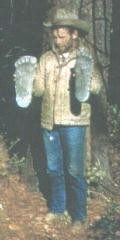
November 20, 2006

FATE May 2004
Book Reviews Page 82-83
The Making of Bigfoot: The Inside Story
By Greg Long
New York: Prometheus Books (New York), 2004, 475 pages; $25
Greg Long’s book is not so much about Bigfoot as it is a well-orchestrated character assassination of Roger Patterson, the man holding the camera at Bluff Creek, California, on October 20, 1967, who allegedly filmed Bigfoot. (Patterson died in 1972.) At 475 pages, it is badly in need of more editing and less about when Greg Long eats chocolate doughnuts (p. 354). Two-thirds of this book is mostly flowery prose that you will have to endure to locate the kernel of the story. That core turns out to be a "he said/he said" tale viewed through Greg Long’s biased sunglasses.
The psychological warfare this book engages in is in evidence from one end of the text to the other. For example, Long wastes no opportunity to frame Roger Patterson using the phrase "little man," 14 times in the first nine pages of chapter one. (Some of the characterizations are extremely harsh, e.g. "the puny little man on his little white horse," p. 22.)
Long has also filled the book full of "innocent" mistakes and interpretations; including these examples:
– Getting the chronology wrong about when Sasquatch researcher John Green got into the field, saying he began with the 1958 Bluff Creek finds (p. 34).
– Projecting psychological feelings on people (e.g. Long writes on p. 452 of a London conference’s preview of the "man-in-the-suit" confession, "much to Coleman’s embarrassment," which, of course, is ridiculous).
– Misidentifying Ivan T. Sanderson, the well-known Scottish zoologist who lived in America, as a "botanist" (p. 163)
– Talking of court records that show that plywood was found in Bob Gimlin’s garage and Gimlin was charged with receiving stolen property. Long reports that the charges were later dismissed (pp. 169-170). What Long forgets to tell his readers, which the Gimlin family shared with me, is that Bob Gimlin was working for the city at the time and the person that told him to store the plywood was his boss, the Chief of Police. Greg Long has chosen what he wants to place in his book in the making of his case. By the time you get to the "confession" of Bob Heironimus (pp. 336ff), the alleged "guy-in-the-suit," you don’t know what or whom to believe. Heironimus started shopping around his story in 1998, according to media reports not mentioned in this book, to try to get some financial rewards from the tabloid The Sun.
Then Heironimus hooked up with Greg Long.
Heironimus’s story is as full of holes as the elusive Bigfoot suit surely must be, if it ever existed and could be found again in 2004. Several questions remain open thanks to Long’s narrative. Most are technical ones, but a few that obviously leap out include:
– When and where did Heironimus meet Patterson and Gimlin?
– Was it a three- or six-piece suit? The book gives both stories.
– Was the alleged Bigfoot suit created from a hide of a red horse skinned by Patterson or an artificial gorilla suit from a guy in North Carolina? The book details both origins.
– Did the Carolina suit maker get paid by Patterson or not? He has said one thing in the book and another to a reporter recently.
– Was Heironimus first approached by Gimlin as noted in the book, or by Patterson, as mentioned on a publicity appearance on MSNBC?
– How did the hair-covered breasts (seen in the October 20, 1967 footage) get on the front of the supposed three- or six-piece "gorilla" suit – despite Long’s "thought" that maybe they were "attached black balloons filled with sand"?
Of course, there’s more to the filming of Bigfoot than meets the eye. An open-mind about all aspects of this melodrama is helpful, but after you wade through this torturous book, you will walk away unsatisfied. I look forward to future examinations of the film. In the meantime, the Patterson-Gimlin footage remains worthy of our time as possible evidence of a filmed furry cryptid primate. And evidence of Bigfoot exists beyond the legacy of Roger Patterson and Greg Long.
– Loren Coleman
About Loren Coleman
Loren Coleman is one of the world’s leading cryptozoologists, some say “the” leading living cryptozoologist. Certainly, he is acknowledged as the current living American researcher and writer who has most popularized cryptozoology in the late 20th and early 21st centuries.
Starting his fieldwork and investigations in 1960, after traveling and trekking extensively in pursuit of cryptozoological mysteries, Coleman began writing to share his experiences in 1969. An honorary member of Ivan T. Sanderson’s Society for the Investigation of the Unexplained in the 1970s, Coleman has been bestowed with similar honorary memberships of the North Idaho College Cryptozoology Club in 1983, and in subsequent years, that of the British Columbia Scientific Cryptozoology Club, CryptoSafari International, and other international organizations. He was also a Life Member and Benefactor of the International Society of Cryptozoology (now-defunct).
Loren Coleman’s daily blog, as a member of the Cryptomundo Team, served as an ongoing avenue of communication for the ever-growing body of cryptozoo news from 2005 through 2013. He returned as an infrequent contributor beginning Halloween week of 2015.
Coleman is the founder in 2003, and current director of the International Cryptozoology Museum in Portland, Maine.
Filed under Bigfoot, Books, Breaking News, CryptoZoo News, Cryptozoology, Reviews, Sasquatch